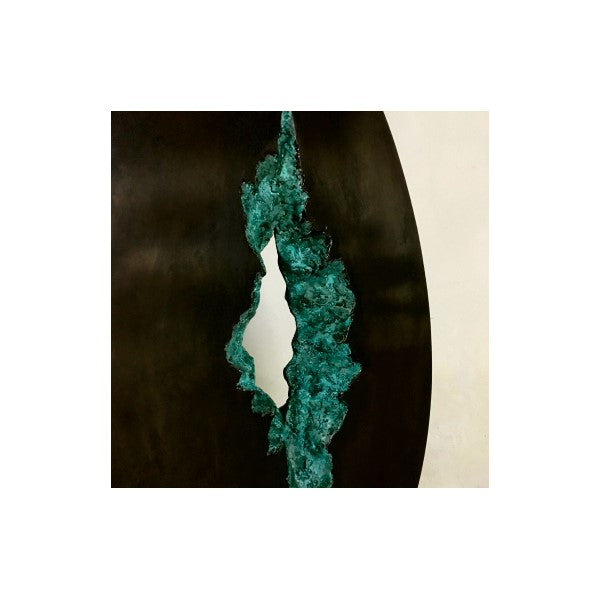Dirty Down Green Verdigris Effect Water Soluble Paint 25ml
Dirty Down Green Verdigris Effect Water Soluble Paint 25ml
6 in stock
Couldn't load pickup availability
Green/blue shade. High matt verdigris corroded copper effect paint. Water soluble to easily tone back effects for the perfect result.
The dark coloured liquid dries to a high matt verdigris colour in 1 to 5 minutes depending on the temperature. Apply verdigris paint by brush or airbrush/sprayer. Verdigris effect paint looks best when applied to rough, textured surfaces.
IMPORTANT:
Before use: Thoroughly shake the pot with the ball bearing rattling and thoroughly stir inside the pot with an old brush until all the lumps are gone.
For best results the pot and the surface being painted should be at room temperature or a little warmer. The colour could dry dark if the surface is too hot or too cold. Tip: keep the pot in your pocket against your skin for an hour before use and shake regularly with the ball bearing rattling. Repeatedly stir and shake the pot until all lumps have gone. It is very difficult to remove the lumps if the liquid is cool or cold.
Usage Instructions:
- Always clean the brush in water or methylated spirit straight after use (not white spirit). Do not let the paint fully harden onto brush.
- The mixture will settle on the bottom of the pot. Thoroughly shake with the ball bearing rattling and stir before each and every use.
- Use paint straight from the pot. Replace the lid quickly during use to prevent the liquid from evaporating. Evaporation with cause the liquid to thicken and the colour to darken.
- To lighten shade add a little water. Do not add water into the paint pot, it’s best tip a little paint into a separate pot and then add small amounts of water. Or to lighten the colour, apply paint to a surface with a damp/wet brush. Or, after painting dab the wet or dry paint with a wet brush.
- Ensure surfaces are clean, dry and grease free. Test the paint on hidden surfaces before use to ensure compatibility and adhesion.
- Only apply to non-porous surfaces such as plastic and metal. Do not apply to porous/absorbent surfaces such as bare timber or paper. The paint can be applied to painted surfaces, but test first. If the effect does not form, try first sealing the surface with varnish.
- Our paint is water soluble and the effects of painting will be lost by washing in water or handling with wet hands. Do not expose paint to rain or splashing with water.
- Looks best when applied to a rough surface.
- To fill dents and grooves in surfaces, first cover the surface with paint, and then wipe the paint off the raised areas with a damp cloth (at an angle to the grooves), leaving some of the paint trapped. The wetter the cloth, the more paint removed.
- When dry, avoid scuffing/scratching the finished paintwork.
For the best results it’s best to practise the different techniques listed below:
- To darken the shade apply more coats. Allow each coat to fully dry before applying another. Any number of coats of paint can be applied over the top of each other. For a broken, patchy effect apply to small areas/patches at a time and allow to dry – more in some areas, less in others.
- The shade will vary depending on the quantity applied. A thick coat of paint will dry a darker shade, and a thin coat of paint will dry a lighter shade.
- Further variations in shade can be created by dabbing a damp or wet brush, cloth or tissue onto the painted surface and then leaving to dry. As the water dries the paint separates into shades of light and dark. The more water used, the greater the effect. This technique can be used after the paint has dried or while it is still wet. Another option is to simply splash water onto the paint and leave to dry – without dabbing.
- For a very dark shade, decant a small amount into a separate pot and allow the paint to evaporate. The more the paint evaporates, the thicker and darker the paint gets.
Brush Application
- Dip the brush and immediately apply to the surface. For a patchy effect dab the paint onto a surface and keep dabbing in the same place until the paint dries. Any number of coats can be applied in this way. For a more even effect paint an even coat onto a surface. A dry, damp or wet brush can be used
- A different effect is obtained depending on whether a soft or stiff brush used to apply the paint.
- Fine Soft Brush: For very detailed work. Apply a small amount to the brush and apply directly to the surface.
- Larger Soft Brush: For apply larger amounts to larger areas. For a darker shade apply larger quantities and for lighter shades apply smaller quantities.
- Stiff Brush: Very light shades can be obtained by dabbing a very small quantity of paint onto a surface using a stiff brush. Allow the paint to dry slightly on the brush for a very light effect, similar to the “dry brushing” painting technique.
Cloth/Tissue Application
- Pour on a cloth or tissue and dab onto a surface and keep dabbing in the same place until the paint dries.
- For a light shade apply a small amount at a time. For a darker shade apply a larger quantity.
Spray Application
- Spray paint onto a surface straight from the pot using an air brush or pressure pot spray gun. Clean air brush immediately after use.
Our paints are water soluble and can be wiped off surfaces in two ways (even when fully dry):
- Using a damp cotton bud.
- Only dampen one end of the cotton bud.
- Wipe paint with the damp end first, and then with the dry end.
- The wetter the cotton bud, the more paint is removed.
- Using a sheet of kitchen roll (absorbent paper towel).
- First apply the paint onto the panels so that they are fully covered, and leave to dry.
- Flatter one end of a piece of kitchen roll, and dip this end into water.
- Remove most of the water from the flat end so that it’s only slight damp. This can be done by pushing the flat end against other dry pieces of kitchen roll.
- Gently press the damp flat end of kitchen roll against the dried paint, and twist the kitchen roll.
- Keep the kitchen roll in one place, do not wipe side to side across the surface. Some paint is left on the model and some removed. Some paint will have been wetted by the damp kitchen roll and will change shade to look darker.
- The wetter the paint gets, the darker the shade. Practice first to check how damp the kitchen roll should be and how much pressure to apply.
Create different shades using water:
- Apply the paint to a surface and apply a small amount of water to the paint as it dries. This usually causes the colours to separate and dry different shades and more patchy.
- Water can be applied to the surface after the paint has fully dried or when the paint is still wet.
SKU:VE-25
View full details





